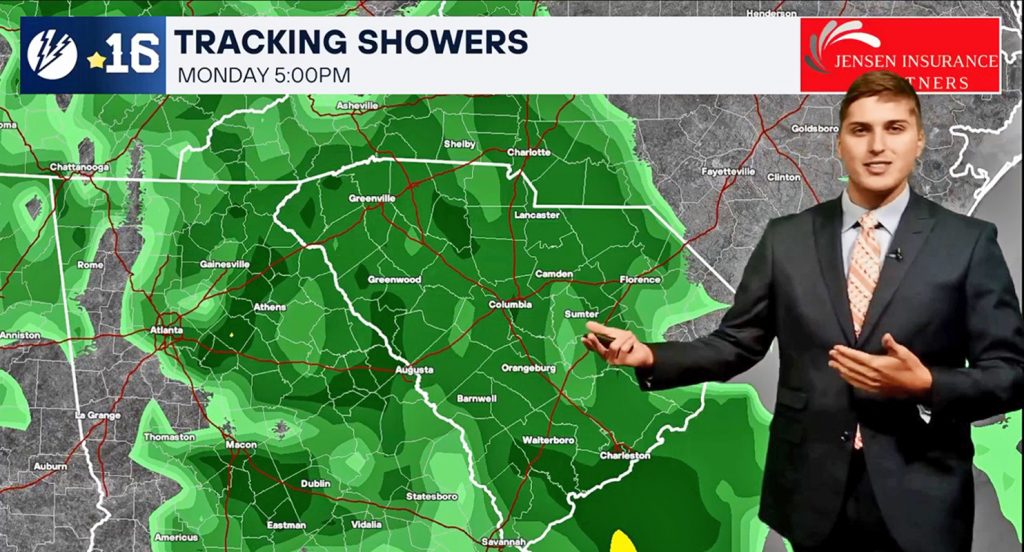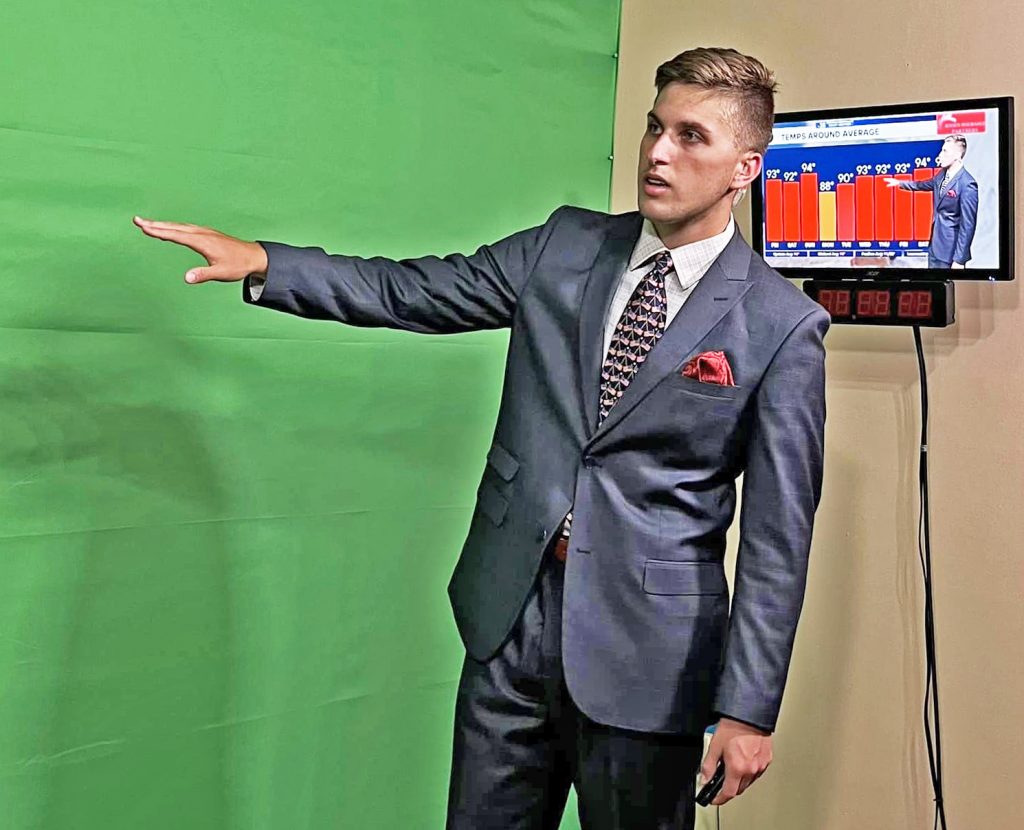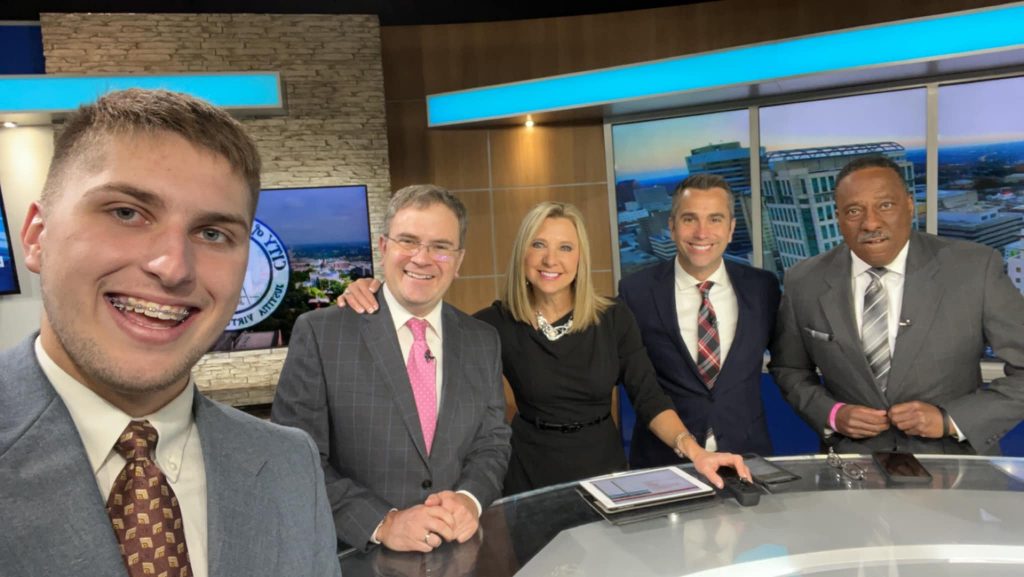
RIDGEWAY – “We are tracking rain for your Sunday,” says an energetic young man in a suit, standing in front of a digital map of South Carolina.
“As these thunderstorms are rolling through, they should drop some heavy rain, so isolated areas could be up to 2 inches, but expect, generally, between a half-an-inch and an inch-and-a-half of rain widespread.”
It’s 17-year-old Will Rowe, giving one of his regular weather reports. For the Gray Collegiate Academy high school student, who lives in Ridgeway, forecasting the weather has been a way of life for a long time.
“It’s just something that I’ve always had a passion for,” he says. “I’ve never considered doing anything else.”
Will says he’s had an interest in watching weather forecast videos since he was in preschool – and, after watching weather forecasts on television with his grandmother, would play at being a weather man with an old road map and a dry erase marker.
He says he started paying closer attention to the weather after the 2015 flood, which had a big impact in parts of South Carolina. He began looking up weather radar online, just to look at it.
In middle school, he started creating his own forecasts, and his interest in weather forecasting prompted him to spend his 7th grade job-shadow day at the National Weather Service in Columbia. As a high school freshman, he went back for another visit and learned how to produce his own video forecast.
It was a visit to a local news station that opened his eyes to the world of video, he says – and he chose that as his next direction.
“At that point, I had no intention of doing anything TV-related; I simply wanted to do the science and research meteorology,” Will says, “but seeing all the cameras and all that, I just thought, ‘Hey, this is pretty cool, I can set this up,’ so I just got a camera, a green screen, got a computer, and got it going.”

It was in the spring of 2020, during the Covid-19 pandemic, that he began making his own forecast videos and posting them on social media.
“I knew how to forecast and stuff because I’d been to the National Weather Service,” he says, “but I just didn’t really know how big it was going to grow – and at that point – during Covid – I didn’t know if people needed to know the weather since everyone mostly stayed in side.”
He went for it, anyway – and, as his online following grew, he acquired more equipment, including a teleprompter, a desk, and six more computer screens.
“When I started off, I was terrible. That’s just kind of how it is,” Will says. “But I kept going. I got some tips, and it got better, and I ended up how I am today. I built better stuff, I have more technology available to me, and I acquired a bunch of connections that gave me new forecasting tips. So, it’s kind of really worked out.”
He’s since visited the weather studios in television news stations in five states – and he’s learned things at each one that, he says have made his forecasting better.

His audience primarily views his forecast videos on Facebook at https://www.facebook.com/WillsWx/, and he says he also has a regular following on YouTube.
He says he’s tried other platforms, but Facebook is the one that’s given him the most consistent views – and it seems to be one his viewers are comfortable with.
He creates his weather forecasts for South Carolina in four regions that line up roughly with the state’s major television markets: the upstate (centered around Greenville/Spartanburg), the midlands (centered around the Columbia area), the PeeDee region (centered around Myrtle Beach), and the low country (centered around Charleston).
Right now, he says, Will’s Weather brings in about $600 a month from local advertising sponsors plus a varying amount from Facebook, which pays him based on the number of comments, likes, shares, and video watches.
The money it generates is part of what’s enabled him to pay for his weather station gear, he says, but he’s also had a lot of support from his dad, who’s helped him fund his passion.
Now a high school senior, he’s looking forward to a career in weather. His plans after graduation include pursuing a college degree – and ultimately a doctorate in atmospheric science – while continuing to operate his online weather station and, hopefully, landing a paid weather internship.
Whether his career path after college graduation takes him to a job at a television news station or further development of his own online weather following, he forecasts a weather-focused future.
“My ultimate goal is to be a severe weather research meteorologist. I want to develop new technologies for severe weather tracking,” he says. “That’s something that I want to do because I think it’s very important that we have the most up-to-date and most advanced technology so we can get the important information that we need for severe weather.”
Of course, right now he’s also still enjoying his last year of high school. He plays football at Gray Collegiate Academy, a public charter school in West Columbia, and his team recently played in the 2A state championship, where they lost by one touchdown.
While he’s certainly thought about playing football at the college level, he says in the long run, a career in weather forecasting may prove to be more lucrative.
“I think I’d rather stick to my career path,” he says, “since I’m already making money, and I already have a straight line to what I want to do.”
As his following on Will’s Weather continues to grow, he acknowledges that it might not be all that long before the online and television worlds converge.
“Talking to all of these news stations, they are relying strictly on the website and social media push so that they can keep the viewers and still keep the followers,” he says, “because you can’t assume that local TV is still going to be around in the next 20 or 30 years.”
And while there’s also concern in the weather world about the potential for computers and artificial intelligence to dominate the world of weather forecasting, he says there are elements of a good, accurate weather forecast that, right now, machines just can’t match.
Unlike weather apps, which just spit out data based on a single, ever-changing weather model, Will says a human weather forecaster can draw on multiple weather models and data sets, plus apply a broader understanding of seasonal and typical weather patterns in each location that the models don’t account for – ultimately creating forecasts that are more accurate and reliable.
But the biggest takeaway from his experience that he’d like to share with other young people is this …you don’t have to wait to grow up to pursue your dreams.
“If you’re passionate about something, you don’t have to wait until you get a degree to start doing what you want to do,” he says.
“You don’t have to say, ‘Oh, well, I can’t do that yet.’ If you just put your foot in the door, I guarantee there’s something somewhere that’s at least related to what you want to do.”











